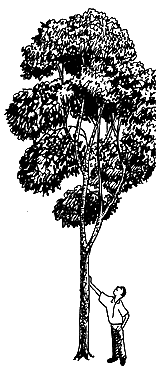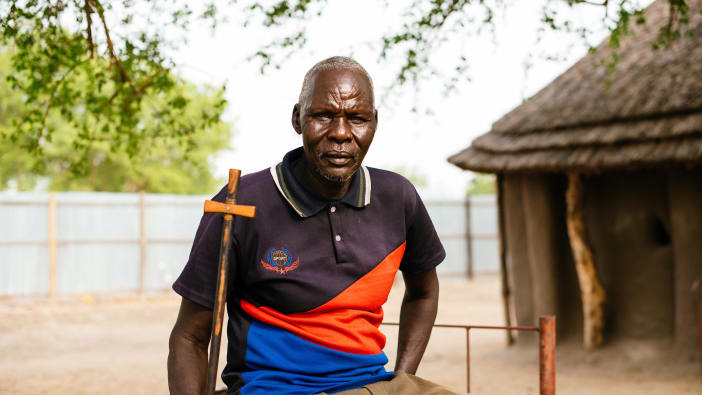
Articles
The tree with healing properties
The forests of south-west Cameroon are a valuable natural resource
1998 Available in English, French, Spanish and Portuguese

From: Coping with conflict – Footsteps 36
Ideas for helping to resolve conflict within and between communities

by Scott Jones.
The forests of SW cameroon are a valuable natural resource. There are many conflicts of interest among and between local people, government agencies and companies.One example is about the harvesting of a useful tree called Prunus africana. A European company uses the Prunus bark to make a medicine to treat a type of cancer. Local people earn money by supplying the company with the bark. Demand for the Prunus bark is high and rapid harvesting threatens its survival.
In one area a long-standing conflict was deepening among villagers, the company and the Ministry of Environment and Forests (MINEF). Staff from a government project were working in the area to manage the conflict. The goal was for everyone involved to reach agreement on how to obtain the benefits from harvesting Prunus without completely destroying it, damaging the environment and being angry with each other.
Prunus africana - rapid harvesting threatens its survival
The conflicts were intense – there seemed to be no way out. Some people were very angry and used force, even physical violence, to get their own way, ignoring the rights of others. Some people lacked confidence and withdrew from any confrontation.
The first meeting
We begin at a village meeting to which interested villagers came. The meeting was run by a three-person team from the government project. The purpose of the meeting was to agree a ‘village’ approach to the next meeting when the company and government ministry would be present.
The meeting started promisingly but soon became heated – it was clear the village was not united. Three main sections of village opinion appeared: the elders, the women and the youths. Each group had different ideas, their own opinion leaders and quiet people. It was clear there were deep conflicts between the groups, not just about the Prunus harvesting. Whilst most shared the goal of gaining income from the Prunus without over-harvesting it, mistrust and misunderstandings were common.
The project team called for a temporary break in the meeting. They then met separately with different groups and individuals. The team listened, came to understand people’s viewpoints and offered suggestions. Tempers cooled as some common ground was established. The village meeting was restarted and progressed well. The villagers did not reach a united position to present to the company. But they did agree that, before this was possible, they had to solve their own problems between elders, women and youths. They also agreed that each person would try to understand others’ points of view and to think creatively to find ways forward. The meeting ended but for several days the team continued to meet with village groups.
The second meeting
The second meeting took place two weeks later. The villagers, a company representative and two government officials were present. The project team again led the meeting but this time they were not neutral: they had an interest in a particular outcome – sustainable management of the forest resources for the benefit of the community. They had stopped being mediators and had, in fact, become brokers (see page 11).
The meeting started badly when several participants arrived late. Each group presented its position and these were discussed. Heated arguments emerged and some participants walked out.
There were two main difficulties. Firstly, the divisions within the village were still very obvious. Secondly, people had high expectations of the meeting. The team called for a break for tempers to cool and for small group discussions to take place. When the meeting restarted, its goal was changed to one of simply trying to understand others’ points of view and concerns. Agreement or solutions would have to come later, after people checked that all points of view had been expressed and understood.
Slow progress
Discussions continued and concerns were brought out into the open. How much bark could be harvested? By whom? How was payment to be calculated? Who would get the money? How much should go to village funds? At times, the debate became heated again. The team skilfully kept the agenda under control.
Final agreement was not reached but progress was made. The meeting had several important outcomes. In spite of the anger and strong emotions, communications had been maintained. Everyone felt a commitment to finding a solution. Everyone had expressed their point of view and had begun to understand the viewpoints of others. The real issues, some of them previously hidden, had been brought out into the open. Everyone agreed to continue with more carefully timetabled objectives – aiming towards a final agreement.
Describing a conflict
Build up a description of the conflict if possible with all the conflicting groups together. It usually helps to write the description down on paper; but don’t do this if illiterate people will feel left out. If appropriate, draw pictures and maps to show the areas of conflict.
- What is the issue?
- Which individuals and groups are involved? Don’t forget to include those who may have withdrawn or whose voice is not being heard.
- What is the viewpoint of each party?
- What are the needs, hopes and concerns of each party?
- What is the history of the conflict, of past misunderstandings and relationships?
- What power does each party have?
- What solutions to the conflict does each party have?
- What solutions may be acceptable to everyone?
Similarly Tagged Content
Share this resource
If you found this resource useful, please share it with others so they can benefit too.

Subscribe to Footsteps magazine
A free digital and print magazine for community development workers. Covering a diverse range of topics, it is published three times a year.
Sign up now - Subscribe to Footsteps magazine




